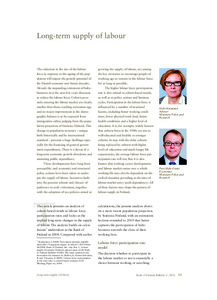Long-term supply of labour
Kinnunen, Helvi; Mäki-Fränti, Petri (29.06.2011)
Numero
3Julkaisija
Bank of Finland
2011
Julkaisun pysyvä osoite on
https://urn.fi/URN:NBN:fi:bof-201408073884Tiivistelmä
The reduction in the size of the labour force in response to the ageing of the population will impair the growth potential of the Finnish economy over future decades. Already the impending retirement of baby-boomers over the next few years threatens to reduce the labour force. Cohorts presently entering the labour market are clearly smaller than those reaching retirement age, and no major improvement in the demo-graphic balance is to be expected from immigration either, judging from the population projection of Statistics Finland. This change in population structure - unique both historically and by international standard - presents a huge challenge especially for the financing of general govern-ment expenditures. There is a threat of a long-term economic growth slowdown and mounting public expenditure. These developments have long been perceptible, and economic and structural policy actions have been taken to under-pin the supply of labour. Incentives built into the pension scheme and closure of pathways to early retirement, together with the adoption of tax policies aimed at growing the supply of labour, arc among the key measures to encourage people of working age to remain in the labour force for as long as possible. The higher labour force participation rate is also related to cohort-based trends, as well as to policy actions and business cycles. Participation in the labour force is influenced by a number of structural factors, including better working conditions, lower physical work load, better health conditions and a higher level of education. It is, for example, widely known that cohorts born in the 1940s are not as well-educated and healthy as younger cohorts. In step with the older cohorts being replaced by cohorts with higher levels of education and much longer life expectancies, the average labour force participation rate will rise. But it is also known that working career developments and labour market status over a whole working life may also be dependent on the cyclical situation prevailing at the time of labour market entry (path dependency). All of these factors may shape the pattern of labour supply in Finland.
